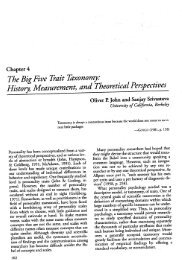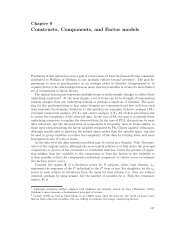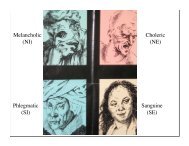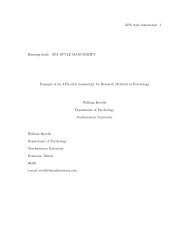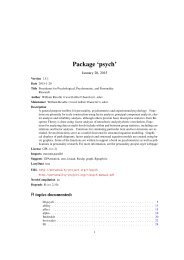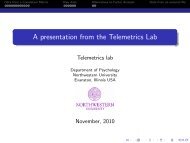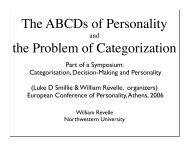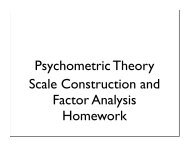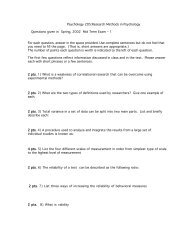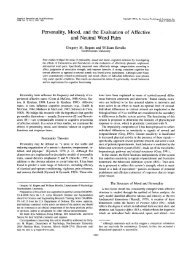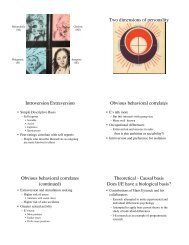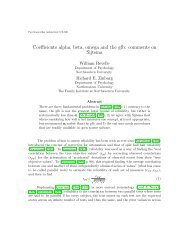Example of an APA-style manuscript for Research Methods in ...
Example of an APA-style manuscript for Research Methods in ...
Example of an APA-style manuscript for Research Methods in ...
- No tags were found...
Create successful ePaper yourself
Turn your PDF publications into a flip-book with our unique Google optimized e-Paper software.
<strong>APA</strong> STYLE MANUSCRIPT 2<strong>of</strong> your study.Follow<strong>in</strong>g the hour glass metaphor, your first few paragraphs should be broad enoughthat someone who knows noth<strong>in</strong>g about the problem will become <strong>in</strong>terested <strong>an</strong>d w<strong>an</strong>t tolearn more. These first two paragraphs are vital, <strong>for</strong> if the reader looks at them <strong>an</strong>d is notexcited, the rest <strong>of</strong> the paper will not be read. The next few paragraphs are aimed at thereader who already knows someth<strong>in</strong>g about the research area <strong>an</strong>d w<strong>an</strong>ts to know why thisparticular paper is worth read<strong>in</strong>g.This first section <strong>of</strong> the article is typically the <strong>in</strong>troduction <strong>an</strong>d, accord<strong>in</strong>g to <strong>APA</strong><strong>style</strong>, should not bear a section head<strong>in</strong>g. 1 Subsequent sections, however, are titled accord<strong>in</strong>gto the psychological conventions.After several paragraphs <strong>of</strong> <strong>in</strong>troduction to your research problem, it is useful to give<strong>an</strong> overview <strong>of</strong> the specific questions you are address<strong>in</strong>g.It is very import<strong>an</strong>t to compare the ‘m<strong>an</strong>uscript’ version <strong>of</strong> this document with thef<strong>in</strong>al ‘journal’ view. Us<strong>in</strong>g L A TEXwe c<strong>an</strong> go back <strong>an</strong>d <strong>for</strong>th between these two <strong>for</strong>mats withease. Tables <strong>an</strong>d Figures need to appear at the end <strong>of</strong> the m<strong>an</strong>uscript version, even thoughthey appear embedded <strong>in</strong> the middle <strong>of</strong> the pr<strong>in</strong>ted version.Experiment 1M<strong>an</strong>uscripts <strong>in</strong> <strong>APA</strong> <strong>style</strong> <strong>of</strong>ten conta<strong>in</strong> descriptions <strong>of</strong> experiments. The <strong>APA</strong> m<strong>an</strong>ualspecifications <strong>for</strong> referr<strong>in</strong>g to experiments are to use a lowercase “e” when speak<strong>in</strong>g generally,as <strong>in</strong> the previous phrase, but <strong>an</strong> uppercase “E” when mention<strong>in</strong>g a particular experiment(as <strong>in</strong> the follow<strong>in</strong>g phrase), such as Experiment 1.MethodThe “method” is a subsection <strong>of</strong> the experimental presentation <strong>in</strong> which all the details<strong>of</strong> sett<strong>in</strong>g up <strong>an</strong>d conduct<strong>in</strong>g the experiment are described. There are a number <strong>of</strong> more orless st<strong>an</strong>dard components to a method, shown below.Particip<strong>an</strong>ts. Psychological experiments are conducted with particip<strong>an</strong>ts, usually hum<strong>an</strong>s.Note that these used to be called “subjects” but apparently <strong>APA</strong> now f<strong>in</strong>ds it<strong>in</strong>appropriate to refer to people with this term. Here we mention how m<strong>an</strong>y particip<strong>an</strong>tsthere were, their ages <strong>an</strong>d other <strong>in</strong><strong>for</strong>mation about them. In particular, how m<strong>an</strong>y weremale <strong>an</strong>d how m<strong>an</strong>y were female. How were they chosen?Apparatus. Sometimes it is necessary to give the apparatus a special section. Thissection c<strong>an</strong> also be called ‘Materials’.The dist<strong>in</strong>ction between materials/apparatus <strong>an</strong>d procedure may be thought <strong>of</strong> <strong>in</strong>terms <strong>of</strong> hav<strong>in</strong>g two research assist<strong>an</strong>ts. One gets the materials ready, the second runsthe particip<strong>an</strong>ts. Everyth<strong>in</strong>g that assist<strong>an</strong>t 1 needs to get ready should be <strong>in</strong> materials/apparatus,everyth<strong>in</strong>g that assist<strong>an</strong>t 2 needs to do is <strong>in</strong> procedure. There should be nosurprises! Assist<strong>an</strong>t 2 should not be told to create a new questionnaire, this should havebeen done by Assist<strong>an</strong>t 1.1 That is, there is no “Introduction” section.



